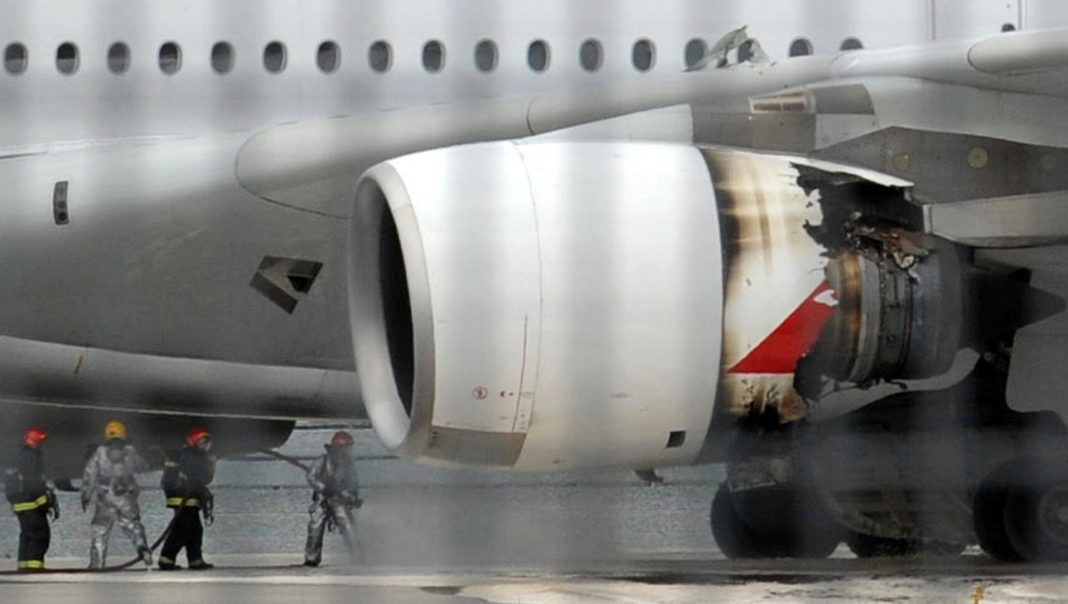10 years ago today, a Qantas Airbus A380 suffered an uncontained engine failure minutes after departure from Singapore’s Changi Airport. Against all odds, the pilots managed to land the plane, and all passengers and crew were disembarked safely. Now, VH-OQA is resting its wings in the California sun, hopefully to return to service in the future. Sadly, the same cannot be said for the hero pilot who saved the flight and all onboard.

Qantas flight 32
VH-OQA was Qantas’ first Airbus A380, and was named Nancy-Bird Walton after the pioneering female aviator of the same name. Also known as the ‘Angel of the Outback’, she was the youngest Australian woman to get a pilot’s license. Just a year after her death, her namesake aircraft was involved in an uncontained engine failure. Perhaps she was the angel watching over that flight because, against all odds, every passenger and crew member walked away unscathed.
Stay informed: Sign up for our daily aviation news digest.
QF32 was a regularly scheduled flight from London to Sydney via Singapore. On November 4th, 2010, VH-OQA departed as planned from Singapore’s Changi Airport on its way to Sydney, with 440 passengers and 29 crew onboard.
Four minutes into the flight, the A380 suffered an uncontained engine failure. Shrapnel from the number 2 engine punctured part of the wing, damaging the fuel system and causing leaks. These leaks caused a fuel tank fire.

If that wasn’t enough, damage to the hydraulic system and anti-lock braking system caused two other engines to go into ‘degraded’ mode. This, combined with damage to the landing flaps and controls for the number 1 engine, made the plane largely uncontrollable. The flight crew entered a holding pattern to assess the situation. They were faced with landing the biggest commercial passenger jet in the world, 50 tonnes over maximum landing weight, with fewer controls than they were used to. It was a dire situation.
After almost two hours of holding, the crew made an attempt to land. Nancy-Bird Walton hit the runway hard and fast. Heavy braking caused four of the tires to blow out, but the aircraft came to a stop with runway to spare.
Although being back on the ground was a relief for the passengers and crew, the drama wasn’t over. Fuel was dripping down onto the hot brakes, and the number 1 engine could not be powered down. Fire crew had to douse the engine on the ground until flameout was achieved. The risk of fire was high, and cabin crew were poised to evacuate the passengers via emergency slide.

Thankfully this wasn’t necessary in the end. Speaking to the Royal Aeronautical Society, pilot David Evans explained,
“We’ve got a situation where there is fuel, hot brakes and an engine that we can’t shut down. And really, the safest place was onboard the aircraft until such time as things changed. So we had the cabin crew with an alert phase the whole time through ready to evacuate, open doors, inflate slides at any moment. As time went by, that danger abated, and, thankfully, we were lucky enough to get everybody off very calmly and very methodically through one set of stairs.”

Down on the ground, the uncontained engine failure launched debris onto houses and cars on the Indonesian island of Batam. Thankfully, nobody on the ground was hurt.

Getting back into service
On inspection, it was found that a turbine disc in the engine had shattered, a result of an improperly manufactured stub oil pipe. Qantas and Singapore Airlines grounded their A380s until all the engines could be inspected. Some engines were changed out, while others had repairs enacted to prevent the fault from occurring again.
VH-OQA was repaired and returned to service in April 2012. She was, in fact, the first Qantas A380 to return with its refurbished cabin and the new first class product onboard, around a year ago.
Sadly, due to the pandemic, the aircraft is currently grounded, resting its wings in the California sun. Qantas has said it will mothball its giant aircraft until 2023 amid the unprecedented downturn in travel demand and the closure of international borders from Australia. In time, hopefully, VH-OQA will return to service.
10 years ago, #QF32 suffered an uncontained engine failure shortly after departure from Singapore and safely returned with no injuries to anyone on board or on the ground. Today, VH-OQA sits resting in the desert hopefully to once again return to the skies. pic.twitter.com/rNW2lFds7S
— Flightradar24 (@flightradar24) November 4, 2020
The pilot who saved QF32 will fly no more
The pilot at the controls of Nancy-Bird Walton was Qantas Captain Richard Champion de Crespigny. He is lauded with being instrumental in the successful landing of the aircraft following the events of QF32, and for saving the passengers onboard. However, it seems his career has come to an untimely end.
Just days before the 10th anniversary of the near-disaster, de Crespigny revealed that he would no longer be working for Qantas, a direct consequence of the current downturn in international travel. Speaking to Australian publication Traveler, he said,
“COVID-19 has terminated my 45-year professional flying career. I am currently stood down and am in limbo, not having flown since March, and will take early retirement effective November 30.”

Although de Crespigny’s flying days may be over, his achievements have not gone unrewarded. His book documenting the events of that fateful day, ‘QF32’, was a best-selling in 2012, and a follow-up book ‘Fly! Life Lessons from the Cockpit of QF32’ was released in 2018. In normal circumstances, he travels the world over, presenting on topics of resilience to various governments and companies, and that’s hopefully something he can continue to do once borders open again.
Do you remember QF32? Has 10 years gone by too fast? Let us know your thoughts in the comments.
[ad_2]
Source link


